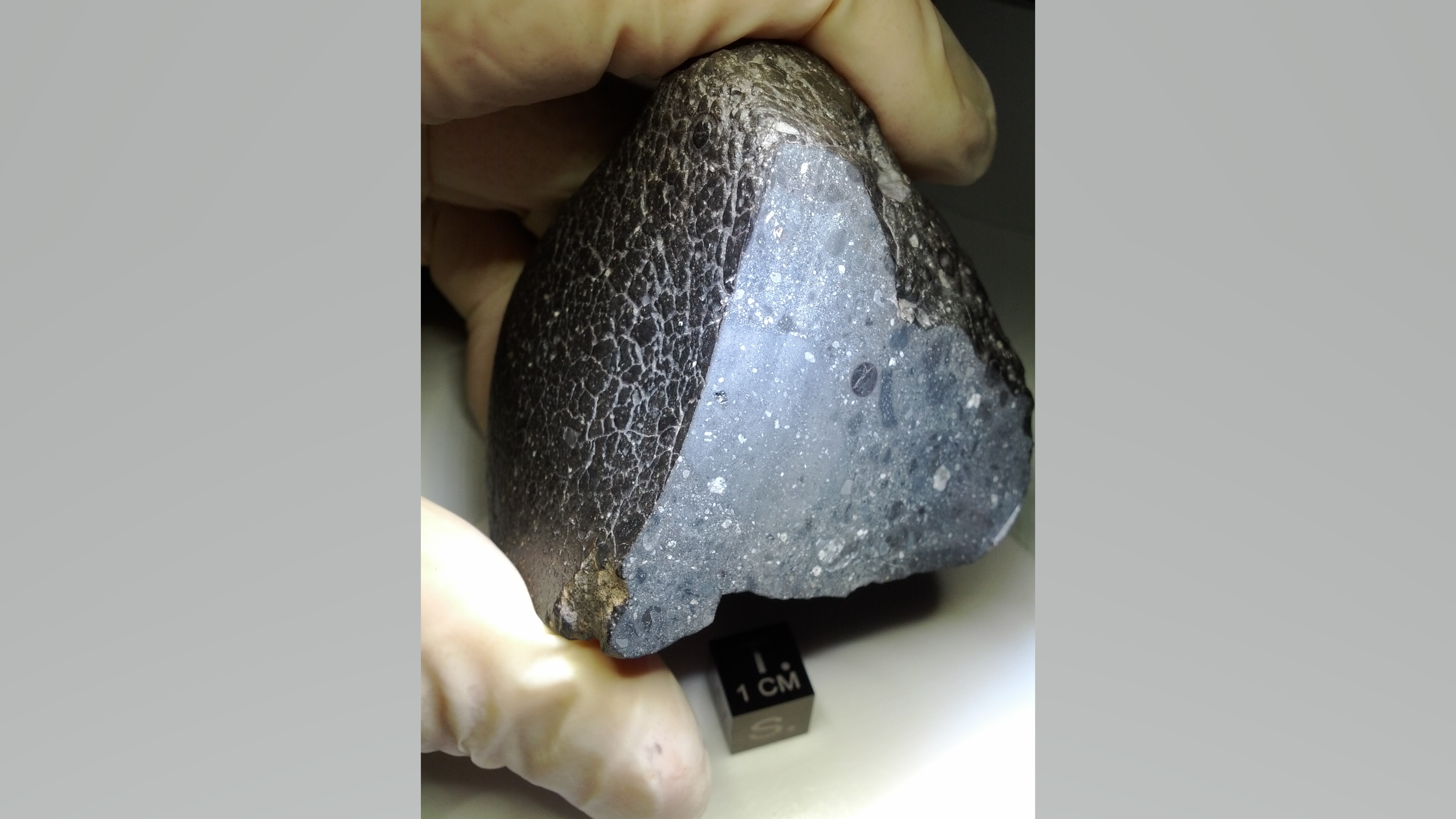Scientists pinpoint Martian origin of 4.5 billion-year-old 'Black Beauty' meteorite
The Martian meteorite is estimated to be 4.5 billion years old.

The birthplace of the oldest known Martian meteorite may have been pinpointed on the Red Planet.
The findings may reveal clues about the origins of Mars, Earth and the solar system's other terrestrial planets.
In a new study, scientists analyzed the 11-ounce (320 grams) meteorite NWA 7034, nicknamed "Black Beauty," which was discovered in Morocco in 2011. Like more than 300 other rocks that have fallen to Earth from space, NWA 7034 came from Mars, blasted off the Red Planet by cosmic impacts.
Related: The chances of early life on Mars faced a meteorite problem
Previous research found that NWA 7034 is the oldest known Martian meteorite, dating to about 4.5 billion years ago. It is also the only so-called brecciated Martian sample available on Earth, meaning it contains angular fragments of multiple rock types cemented together. In contrast, all other known Martian meteorites contain single rock types.
Until now, scientists did not know precisely where on Mars NWA 7034 came from. Now, researchers may have pinpointed Black Beauty's exact point of origin.
In the new study, the scientists used supercomputers to analyze images of the Martian surface. "My team and I developed a crater-detection algorithm to detect all impact craters, down to about 100 meters [330 feet] in diameter, seen on high-resolution images covering the surface of Mars, about 94 million in total," study lead author Anthony Lagain, a planetary scientist at Curtin University in Perth, Australia, told Space.com.
Get the Space.com Newsletter
Breaking space news, the latest updates on rocket launches, skywatching events and more!
When the researchers investigated the sizes and locations of these craters, they realized that most of the smallest craters were scattered around larger craters that were more than 1.8 miles (3 kilometers) wide and less than 10 million years old. These findings suggest that these small craters were formed by the debris from larger impacts after they fell back to the surface. The relatively fresh origin of all these craters helped explain why the smallest ones were still detectable: Millions of years of erosion and other activity on Mars had not yet erased them.

The scientists identified 19 craters as the most likely points of origin for the Martian meteorites on Earth. When they compared the properties of these craters with those of NWA 7034, they found that just one crater proved a match, Lagain said. They named this crater after the Australian city of Karratha, which is home to one of the oldest rocks on Earth.
The findings suggest that the oldest fragments of NWA 7034 were likely dug out from Mars 1.5 billion years ago by the cosmic impact that formed the 24-mile-wide (40 km) Khujirt crater in the Red Planet's southern hemisphere. These ancient fragments, along with the rest of NWA 7034, were later blasted off Mars by a subsequent impact 5 million to 10 million years ago, which formed Karratha crater.
"The origin of Martian meteorites was an old enigma," Lagain said. Discovering the birthplace of one "is pretty much equivalent to a free sample-return mission," he noted.
"Now we know that the rock comes from the Terra Cimmeria-Sirenum province," Lagain said. "This region hosts the clues to understand[ing] the first stage of evolution and differentiation of the planet. If one wants to understand how Mars formed and evolved, then we need to analyze this province much more than we do right now."
The findings suggest that sending a rover or drone to this region "would help us understand what happened 4.5 billion years ago on Mars," soon after the Red Planet, Earth and the solar system's other rocky worlds were born, Lagain said. This information, in turn, may help "fill the gap in knowledge for the same period of time on Earth."
The scientists detailed their findings online July 12 in the journal Nature Communications.
Follow us on Twitter @Spacedotcom and on Facebook.
Join our Space Forums to keep talking space on the latest missions, night sky and more! And if you have a news tip, correction or comment, let us know at: community@space.com.

Charles Q. Choi is a contributing writer for Space.com and Live Science. He covers all things human origins and astronomy as well as physics, animals and general science topics. Charles has a Master of Arts degree from the University of Missouri-Columbia, School of Journalism and a Bachelor of Arts degree from the University of South Florida. Charles has visited every continent on Earth, drinking rancid yak butter tea in Lhasa, snorkeling with sea lions in the Galapagos and even climbing an iceberg in Antarctica. Visit him at http://www.sciwriter.us









